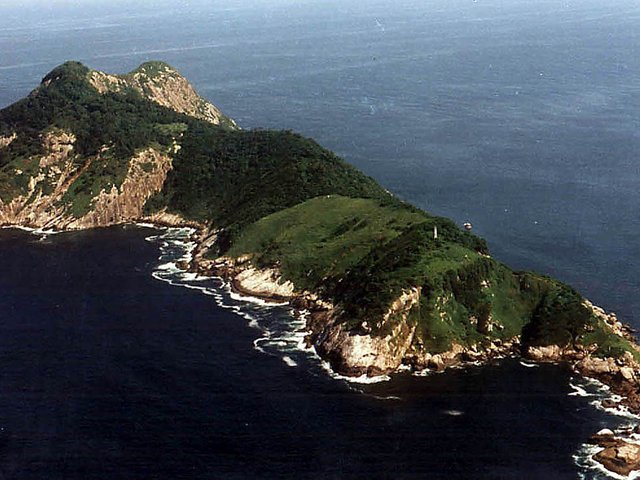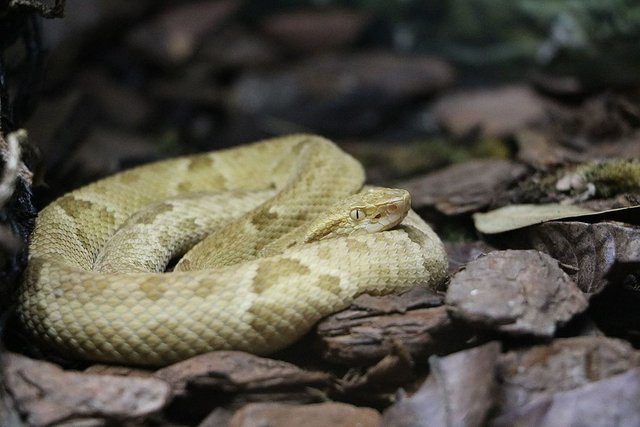Snake Island (Ilha de Queimada Grande)

The photo above is an aerial view of the island of Ilha de Queimada Grande, Brazil. At first glance, it may look amazing, and it looks like the perfect place to spend an exotic vacation. But the scenery of this beautiful island can actually deceive. If we set foot on this island, then death will haunt us. Because the island is inhabited by thousands of snakes from one of the most venomous snakes in the world.
Ilha da Queimada Grande, nicknamed Snake Island, is an island of 430,000 square meters (43 hectares) located about 33 km off the coast of the state of São Paulo, Brazil. This island is home to a variety of snakes including endemic species called Golden Lancehead (Bothrops insularis), which is one of the most venomous snakes in the world. According to estimates by 2015, there are between two to four thousand snakes on the island, which is equivalent to an average of one snake per 75 square meters across the island. Excessive claims suggest there are as many as five snakes per square meter. The local folklore is also filled with stories of horrific deaths suffered by those who walked on the beach including a fisherman who landed to the island to find bananas, and the families of the lighthouse keepers who lived there.
Officially, there has never been a report of a human being bitten by a golden lancehead snake, so its human toxicity cannot be tested, but other lancehead species are responsible for morbidity and human deaths more than any other type of snake in the whole of America. A bite from a lancehead carries a seven percent chance of death, and even with treatment, the victim still has a three percent chance of death. Death usually occurs due to intestinal bleeding, kidney failure, bleeding in the brain and severe necrosis of muscle tissue. Can actually melt flesh and tissue making it easier for snakes to digest. Tests have found that the golden lancehead viper can be the fastest reacting in the genus Bothrops. A golden lancehead can kill almost any prey (and melt human flesh) almost instantaneously.

image bywikimedia
Actually, the lancehead snakes in Queimada Grande were originally the same species as those on land when the islands and land were still connected. Between 10,000 and 12,000 years ago when sea levels rose, Queimada Grande was isolated from the Brazilian mainland and the snake population there. Isolated territories cause island snakes to have no predators, but on the other hand, their food sources are virtually absent. In the absence of small mammals to be hunted, snakes adapt to trees, as they survive by eating birds that stop at the island during migration. The island snakes learn to hold their bodies high in the trees by the tail and grab the birds that rest on the branches. They can also grow to be five times stronger than their brothers on the mainland. It is necessary to kill the birds faster, otherwise, their prey will fly away. When no birds pass, they fill their stomachs with lizards, centipedes, snails, and frogs.
The Brazilian government has banned people from visiting the island, except for some scientists to study gold lanceheads and that too requires special approval. Though dangerous, wildlife smugglers sometimes sneak into the island to catch some golden lanceheads because of their high prices on the black market.
Folklore
Of course, where there are predators, there will be local legends. There are two local legends associated with Ilha de Queimada Grande. According to one story, a fisherman once wanders into the island unknowingly, to pick up some bananas. He was soon bitten but made it back to his boat. However, the rapid reaction of the poison, he was found dead in a pool of his blood a few days later in his drifting boat.
The second legend tells of a bloody event from the last operator of the lighthouse on the island and his family. It is said that one night, some snakes came through the window and attacked him, his wife and their three children. They tried to run to their boats to escape, but the venomous snakes that hung on the branches of trees and along the way, biting them so they died before reaching the shore. The question is ... How did the family live there before?
And in fact, the Brazilian Navy always sends teams to this island every year for the maintenance of the lighthouse, which, since the 1920s, has been automated.
Best regard @h4f
Reference :
https://www.smithsonianmag.com/science-nature/snake-infested-island-deadliest-place-brazil-180951782/
http://www.odditycentral.com/pics/ilha-de-queimada-grande-brazils-scary-snake-island.html
http://www.messagetoeagle.com/ilha-de-queimada-grande-the-snake-island-is-worlds-deadliest-island/
http://www.mashpedia.com/Ilha_da_Queimada_Grande
Congratulations! This post has been upvoted from the communal account, @minnowsupport, by h4f from the Minnow Support Project. It's a witness project run by aggroed, ausbitbank, teamsteem, theprophet0, someguy123, neoxian, followbtcnews, and netuoso. The goal is to help Steemit grow by supporting Minnows. Please find us at the Peace, Abundance, and Liberty Network (PALnet) Discord Channel. It's a completely public and open space to all members of the Steemit community who voluntarily choose to be there.
If you would like to delegate to the Minnow Support Project you can do so by clicking on the following links: 50SP, 100SP, 250SP, 500SP, 1000SP, 5000SP.
Be sure to leave at least 50SP undelegated on your account.